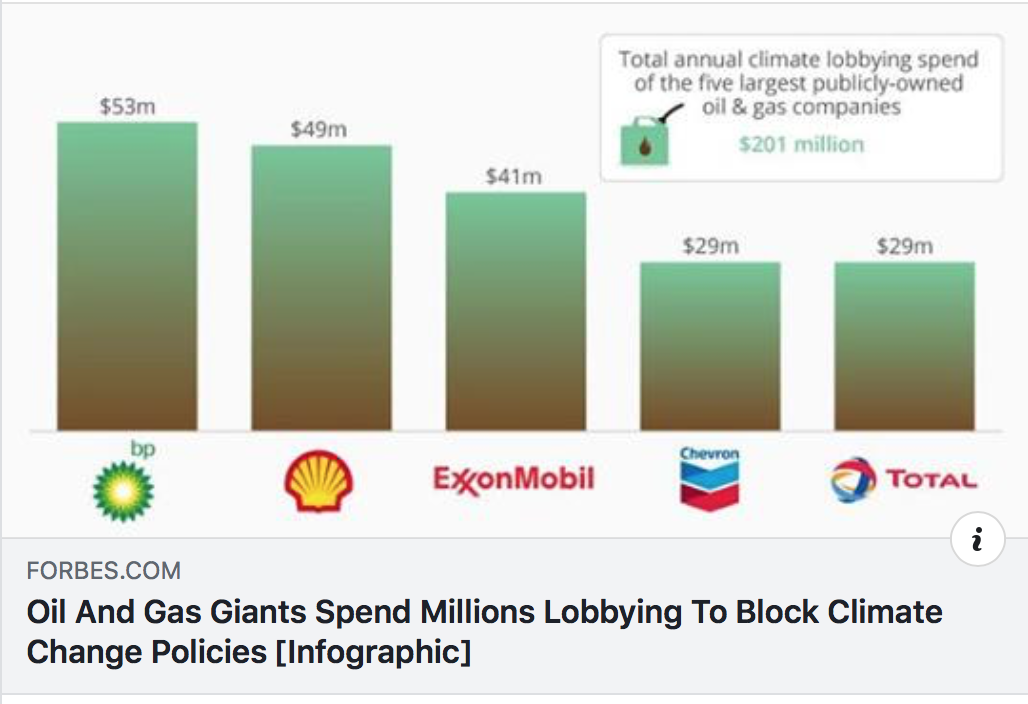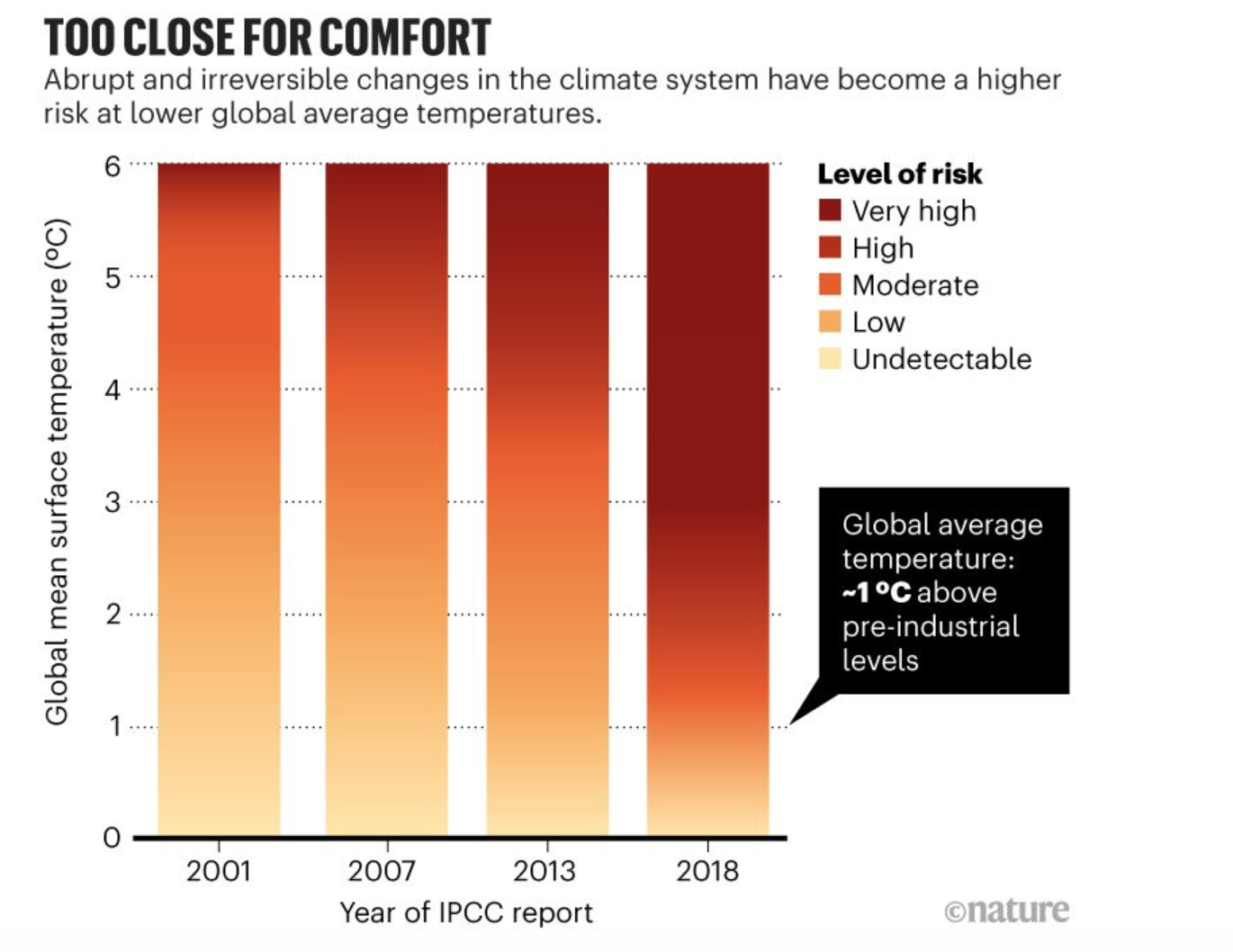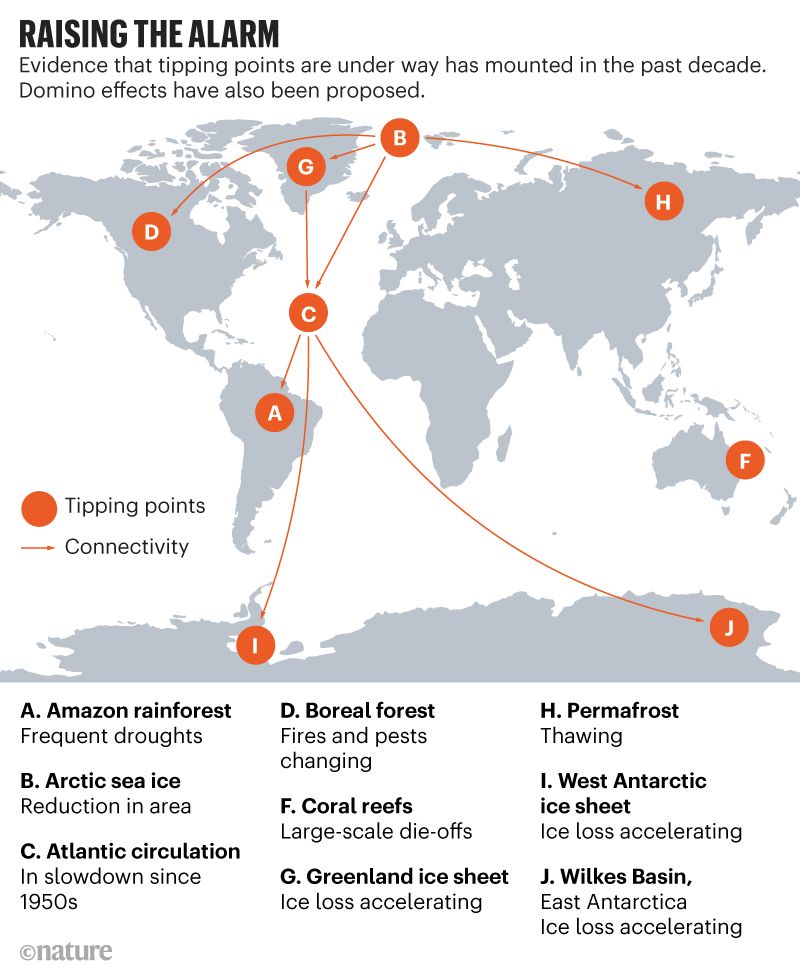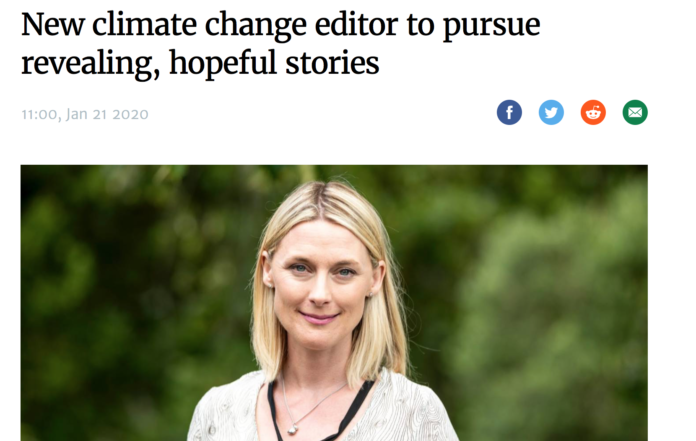Climate deniers are on their way out.
As more and more extreme weather events erupt at an ever increasing pace, pretending that the climate isn’t changing rapidly in front of our eyes is no longer a game anyone wanting to be taken seriously can afford to play any longer.
This Australian clown has put an end to denialism as his nation burns.

Those Australians who voted right wing and put Morrison in are now the same Australians burning. There’s a delicious irony in the sudden change in their views on global warming.
Those eery orange skies above Auckland put the shits up even the most determined climate denier didn’t they?
That’s why middle class positive climate journalism is the next cultural problem to overcome.
No one believes that the climate isn’t rapidly changing. The science clearly states human generated pollution is causing it and the big oil companies knew back in the 1990s and they lied about it, so rather than support climate denial propaganda…

…they should start sponsoring bullshit positivity climate change journalism.
The Middle Classes will be as difficult to overcome as older white boomers when it comes to climate change. Older white boomers are climate deniers because they culturally feel alienated from debate and hate admitting environmentalists are right. The Middle Classes benefit immensely from the form of capitalism that is making climate change such a crisis and rather than outright denial, because that isn’t culturally acceptable amongst middle class dinner parties, the denial here is all wrapped up in positive bullshit.
Car pooling, electric cars, solar panels, frenetic recycling and plastic minimisation are all held up as some sort of means for change when the reality is none of that will do a damned thing to prepare us for the radical adaption required.
The Middle Classes in NZ have been the biggest hurdle to affordable housing once they all become property investors, their new positive ‘if everyone just does their bit’ climate bullshit will be equally disastrous for meaningful climate change policy.
Let me break it down for you.

Increasing methane (which is more than 20 times more heat holding than C02 but only stays in the atmosphere for a decade) released from the thawing permafrost and warming oceans creates an enormous heat spike and trips a run away heat event that melts all of Greenland and Antarctica. This sudden release of huge amounts of fresh water into the ultra sensitive ocean pumps in the Labrador Sea shuts down the entire Ocean conveyor current that takes heat from the tropics and makes most of Western Europe habitable, this in turn plunges the planet into freezing temperatures as the heat never transfers north and we inadvertently generate an ice age once the methane passes…
The palaeo-record shows global tipping, such as the entry into ice-age cycles 2.6 million years ago and their switch in amplitude and frequency around one million years ago, which models are only just capable of simulating. Regional tipping occurred repeatedly within and at the end of the last ice age, between 80,000 and 10,000 years ago (the Dansgaard–Oeschger and Heinrich events). Although this is not directly applicable to the present interglacial period, it highlights that the Earth system has been unstable across multiple timescales before, under relatively weak forcing caused by changes in Earth’s orbit. Now we are strongly forcing the system, with atmospheric CO2 concentration and global temperature increasing at rates that are an order of magnitude higher than those during the most recent deglaciation.

So within the space of decades we go from 10 degrees+ heat waves to freezing cold, the inability of species to be able to adapt within the space of 30 years to such extremes causes vast extinctions and leaves most of the planet uninhabitable for complex civilisations.
Among the surprises that have emerged from analyses of oxygen isotopes in ice cores (long cylinders of ice collected by drilling through glaciers and ice sheets) has been the recognition of very sudden, short-lived climate changes. Ice core records in samples extracted from Greenland, Antarctica, Canada’s Arctic Archipelago, and high mountain glaciers in South America show that these climate changes have been large, very rapid, and globally synchronous. Over a period of a few years to a few decades, average temperatures have shifted by up to half of the temperature differences seen between the Pleistocene ice ages and their interglacial periods—that is, as much as 5–15 °C (9–27 °F).
This is not getting better, the temperatures are only going up and once the heat becomes a run away event radical solutions for adaptation will become the only solutions.
No amount of positive media coverage is going to fix this.






Martyn, the scenario you have presented -‘this in turn plunges the planet into freezing temperatures’-is incorrect. Ice ages occurred because in recent geological times there was much less CO2 in the atmosphere and oceans than now, i.e. 800,000-year record:
https://scripps.ucsd.edu/programs/keelingcurve/wp-content/plugins/sio-bluemoon/graphs/co2_800k.png
Desequestering carbon (in the form of coal) and desequestering hydrocarbons (in the form of oil and gas) and burning them has altered the geochemistry of the Earth to such an extent previous macroclimate events no longer apply.
In other words, as long as industrial humans keep burning fossil fuels the Earth will continue to overheat. Indeed, there may well already be sufficient disturbance to the geochemistry that even if humanity ceased burning fossil fuels tomorrow the Earth would continue to overheat for many decades. Continuing on the present path guarantees catastrophic overheating, and the commensurate meltdown of ice.
It would take a long time for Antarctic ice to substantially melt, but the ice on Greenland is very vulnerable to melting, and will generate about 7 metres of sea level rise when it does go -arguably towards the end of this century.
The effect of overheating on methane clathrates on the bottom of arctic seas is still unknown. Eruption of that would certainly exacerbate the overheating we are currently enduring.
Just as scary is the accumulation of lesser known gases such as nitrous oxide and the recently reported catastrophe-in-the-making:
‘Study finds shock rise in levels of potent greenhouse gas’
https://www.theguardian.com/environment/2020/jan/21/study-finds-shock-rise-in-levels-of-potent-greenhouse-gas-hfc-23
‘Scientists say one tonne of HFC-23 emissions is equivalent to the release of more than 12,000 tonnes of carbon dioxide.’
Humans need to stop harvesting energy and live much simpler lives in small self sufficient communities which concentrate on growing food and restoring the environment.
Human numbers have to fall and will as we starve through lack of preparation for the changes ahead that are now unavoidable.
The two questions are
How can we stop making it worse than what we have made it to date.
What do we have to do to shift to small eco conscious communities.
Yes deaths on a scale not seen before are unavoidable. We must look beyond that horror and plan long term.
The power of community to direct and conserve resources does not include corporate for profit thinking.
Extinction Foretold, Extinction Ignored
This essay is updated periodically to accommodate recent evidence. It was last updated 14 January 2020.
My December 2018 essay, “Ocean Deoxygenation as an Indicator of Abrupt Climate Change,” provides an overview of the marine response to abrupt climate change. It is linked here.
Most evolving lineages, human or otherwise, when threatened with extinction, don’t do anything special to avoid it
~ George C. Williams
American evolutionary biologist George C. Williams died in September 2010 at the age of 83 years. I doubt he knew we were facing our own imminent extinction.
By the time Williams died, I had been sounding the alarm in this space for three years. I was not alone. The warnings I will mention in this short essay were hardly the first ones about climate catastrophe likely to result from burning fossil fuels. A little time with your favorite online search engine will take you to George Perkins Marsh sounding the alarm in 1847, Svente Arrhenius’s relevant journal article in 1896, and young versions of Al Gore, Carl Sagan, and James Hansen testifying before the United States Congress in the 1980s. There is more, of course, all ignored for a few dollars in a few pockets.
The projected rate of climate change based on IPCC-style gradualism outstrips the adaptive response of vertebrates by a factor of 10,000 times. Closer to home Homo sapiens, mammals cannot evolve fast enough to escape the current extinction crisis. Humans are vertebrate mammals. To believe that our species can avoid extinction, even as non-human vertebrates and non-human mammals disappear, is classic human hubris wrapped in a warm blanket of myth-based human supremacy. The evidence indicates humans will join the annihilation of “all life on earth,” as reported in the journal literature on 13 November 2018. Even tardigrades, the go-to survivor for those who deny the impacts of abrupt climate change on life, are unlikely to survive, according to a paper in the 9 January 2020 issue of Scientific Reports. If the organisms on which we depend do not survive, if even tardigrades do not survive, then humans will not survive. We depend greatly upon invertebrates for our continued existence, yet an “insect apocalypse” is under way, as reported in a review paper in the April 2019 issue of Biological Conservation and subsequently confirmed in a 30 October 2019 paper in Nature.
The uncontrolled meltdown of the world’s nuclear power facilities is sufficient but not necessary for the near-term loss of life on Earth. “Only” abrupt climate change is necessary to rid Earth of all life. In fact, it appears air travel alone will catastrophically overheat the planet: “The contrails left by aeroplanes last only hours. But they are now so widespread that their warming effect is greater than that of all the carbon dioxide emitted by aeroplanes that has accumulated in the atmosphere since the first flight of the Wright brothers.” According to a paper in the 27 Jun 2019 issue of Atmospheric Chemistry and Physics, cirrus clouds engendered by air travel have caused tremendous planetary warming, a trend likely to accelerate in future scenarios that include industrial civilization. Adding to the existential risk from commercial air travel is a peer-reviewed publication pre-printed 12 December 2019 indicating its effects on atmospheric circulation are sufficient to endanger all life on Earth.
The response to these warnings, throughout history? Shift the baseline. Ignore the abundant science. Throw caution to the wind. And, for the IPCC, retain a remarkably conservative approach (according to the remarkably conservative peer-reviewed literature).
The corporate media, governments, and most climate scientists continue to adhere to the 2 C target proposed by economist William Nordhaus in 1977: “If there were global temperatures more than 2C or 3C above the current average temperature, this would take the climate outside of the range of observations which have been made over the last several hundred thousand years.”
We know quite a bit more about climate science than we did in 1977. And real scientists knew, even way back then, that economists were not to be treated as scientists. It’s small wonder Nordhaus shared the politically motivated Nobel Prize in Economics earlier in 2018. I wouldn’t have been surprised had he been given the Nobel Peace Prize, thus joining fellow partners-in-crime specialists-in-genocide Henry Kissinger and Barack Obama.
Earth is at least 1.73 C above the 1750 baseline marking the beginning of the Industrial Revolution. This global-average temperature is the highest ever with Homo sapiens present, according to a 2017 paper in Earth System Dynamics by James Hansen and colleagues. In other words, our species has never experienced a hotter Earth than the one currently driving the ongoing refugee crisis as habitat for humans disappears. Earth is not quite at the 2 C limit (sic) established by Nordhaus, yet we have entered a “new climate regime,” as pointed out in pre-print of the June issue of Earth’s Future: “Overall, our results suggest that we have entered a new climate regime in which the occurrence of extraordinary global-scale heatwaves cannot be explained without human-induced climate change.”
According to an overview published by European Strategy and Policy Analysis System in April 2019: “An increase of 1.5 degrees is the maximum the planet can tolerate; should temperatures increase further … we will face even more droughts, floods, extreme heat and poverty … and at worst, the extinction of humankind altogether.” In other words, according to this major synthesis, we’ve passed the point beyond which human extinction might occur.
In response to the ever-accelerating crisis known as abrupt climate change, the conventional approach is to shift the baseline. Instead of admitting the planet is nearly 2 C above the 1750 baseline, governments and many scientists have determined the baseline is actually 1981-2010, or later. Adherence to the Precautionary Principle is clearly unfashionable.
We have known for decades that the 2 C number set in stone by Nordhaus is dangerous. We were ”running out of time” to deal with greenhouse gases in 1965, according to the chief of the American Petroleum Institute. Fourteen years later, it was Edward Teller informing Big Oil they needed to change. Exxon accurately predicted where we were headed in 1982, and not only failed to heed the warnings, but kicked the warnings and the future of humanity to the curb. Al Gore and Carl Sagan testified to Congress in 1985 that we must act now on climate change. In late June 1989 Noel Brown, the director of the New York office of the United Nations Environment Program indicated we had only until 2000 to avoid catastrophic climate change. About 16 months after Brown’s warning, the United Nations Advisory Group on Greenhouse Gases set 1 C as the absolute upper limit in October 1990. Climate speaker and writer David Spratt said 0.5 C was the upper limit in October 2014.
It was probably too late to reverse abrupt, irreversible climate change in 1977 when Nordhaus shared his genocidal opinion. It certainly was too late to change course in 1989. And comforting words aside, we haven’t done anything to prevent our own extinction in the wake of warnings distant or near.
In October 2018, the United Nation’s Intergovernmental Panel on Climate Change indicated we have until 2030 to hold global-average temperature at 1.5 C above the ever-shifting baseline. Yes, that’s correct: The United Nations is recommending a global-average temperature well below the current temperature as a “target.”
A review of the role and importance of methane hydrates in the East Siberian Arctic shelf (ESAS) by Shakhova and colleagues was published 5 June 2019 in Geosciences. Among the conclusions of this research: ESAS “has recently been shown to be a significant modern source of atmospheric CH4, contributing annually no less than terrestrial Arctic ecosystems …. Releases could potentially increase by 3–5 orders of magnitude.” Any such significant release of methane obviously would cause a near-term loss of habitat for humans on Earth. An ice-free Arctic will be equivalent to 25 years of carbon dioxide emissions, according to a paper in the 20 June 2019 issue of Geophysical Research Letters.
According to a paper in the 7 June 2019 issue of Science, the amount of methane in the atmosphere (CH4) began to rise in 2007 after a 7-year period of near-zero growth. Recent research shows that a second step change occurred in 2014. From 2014 to at least the end of 2018, the amount of CH4 in the atmosphere increased at nearly double the rate observed since 2007.
Even the corporate media are finally reporting the bubbling of subsea methane. On 8 October 2019, Newsweek quoted Igor Semiletov of Tomsk Polytechnic University: “This is the most powerful gas fountain I’ve ever seen.”
It gets worse, of course: United Nations Secretary-General António Guterres says we have until 2020 to turn this ship around. In early October 2018, according to the Guardian, “the next three months are crucial for the future of the planet.” Of course, nothing of significance was done at the planetary level because nothing of significance could be done. Ever willing to continue distracting the masses, the Prince of Wales concluded we have 18 months to deal with climate change in mid-July, 2019. The only known means by which humans can change the global-average temperature in any direction between now and 2020 (or 2021) is the reduction of industrial activity, which will alleviate the aerosol masking effect and therefore drive the global-average much higher very quickly. The impact of the aerosol masking effect has been greatly underestimated, as pointed out in an 8 February 2019 article in Science. As pointed out by the lead author of the paper in Science on 22 January 2019: “Global efforts to improve air quality by developing cleaner fuels and burning less coal could end up harming our planet by reducing the number of aerosols in the atmosphere, and by doing so, diminishing aerosols’ cooling ability to offset global warming.” The cooling effect is “nearly twice what scientists previously thought,” and this 2019 paper cites the conclusion by Levy et al. (2013) indicating as little as 35% reduction in industrial activity drives a 1 C global-average rise in temperature. Additional support for the importance of the aerosol masking effect comes in the 18 July 2019 issue of Geophysical Research Letters and also from the 27 November 2019 issue of Nature Communications. Additional research indicates loss of aerosols exacerbates heat waves. So, too, does the ongoing, abrupt loss of Arctic ice. This Catch-22 of abrupt climate change, termed the McPherson Paradox, takes us in the wrong direction regardless of the direction of industrial activity if we are interested in maintaining habitat for vertebrates and mammals on Earth. Reduction or loss of the aerosol masking effect means loss of habitat for human animals, with human extinction soon to follow.
It gets unimaginably worse by the day, of course. Recent information from the peer-reviewed journal literature finally caught up to me in concluding the Sixth Mass Extinction could annihilate all life on Earth. A paper in Scientific Reports draws this conclusion based upon the rate of environmental change, consistent with my own conclusions. More than a decade after I began pointing out in this space the importance of interactions between organisms, particularly the relatively unknown yet important microbes, microbial life is deemed important in a synthetic paper in the 18 June 2019 issue of Nature Reviews Microbiology: “[Microbes] support the existence of all higher lifeforms and are critically important in regulating climate change.” Five-and-a-half years after I described the horrors of interacting factors, a paper in the 21 December 2018 issue of Science concludes such interactions are tremendously important. Following up on 10 January 2019, a paper in the same publication points to ocean temperatures increasing much faster than expected, thereby ensuring 2018 as the year with the warmest oceans ever recorded on Earth. As one result, Antarctica is losing ice mass at six times the rate of 40 years ago, according to a paper in the 14 January 2019 issue of Proceedings of the National Academy of Sciences. Further confirmation that Antarctic ice is diminishing rapidly comes from work published in Geophysical Research Letters on 16 May 2019. According to a paper in the 1 July 2019 issue of Proceedings of the National Academy of Sciences, the decrease in Antarctic sea ice during the 2014–2017 period far exceeded the more widely publicized decay rates experienced in the Arctic, thereby reducing Antarctic sea ice extents to their lowest values in the 40-y record. Antarctic ice melted at the highest rate ever observed on 24 December 2019, according to Newsweek, with strong scientific support.
Climates “like those of the Pliocene will prevail as soon as 2030,” based on the stunningly conservative Representative Concentration Pathways of the IPCC (RCPs), and this rate of environmental change will destroy habitat for humans and most other species on Earth. Any informed peek at RCPs will reveal the rapidity with which global overheating makes them obsolete.
Meanwhile, “roughly 430 million years ago, during the Earth’s Silurian Period, global oceans were experiencing changes that would seem eerily familiar today. Melting polar ice sheets meant sea levels were steadily rising, and ocean oxygen was falling fast around the world.” In other words, the Ireviken extinction event is stunningly similar to the Sixth Mass Extinction in which we are currently participating, according to a paper in the 1 May 2019 issue of Earth and Planetary Science Letters.
Ocean acidification is occurring at a rapid pace, according to a paper in the 26 August 2019 issue of Nature Climate Change. As one result, diatom silica production is rapidly declining. This rapid demise in plankton is of primary concern to those of us who depend upon the ocean for food or oxygen.
Finally, a paper in Geosciences dated 23 November 2018 indicates up to 8516 ppm by volume in the Yamal region of Siberia, indicating the great potential for terrestrial permafrost to warm the planet in the near future. An article in the 1 July 2019 issue of Nature Geoscience indicates “a loss of soil carbon of 5.4% per year.” In other words, it is not only the 50-Gt burst of methane described by Shakhova and colleagues as “highly possible for abrupt release at any time” in 2008 that poses an existential threat based on methane alone. A paper in the 30 October 2019 issue of Nature Climate Change indicates abrupt, not gradual, release of methane from terrestrial permafrost. As one who loves life, my gratification from these most conservative of sources is overwhelmed by my sadness at the loss.
To put it simply, our fate as a species is sealed. We’re headed for extinction in the very near term despite warnings dating more than 150 years. It’s a tragic tale. And, as foretold by evolutionary biologist George C. Williams, our species hardly made a squeak as the hammer dropped. https://guymcpherson.com/extinction_foretold_extinction_ignored/
Guy has a big following but is not likely to have it right.
Sure disaster lies ahead. Its the shape of how it will play out that cannot be specifically described.
Hi John W 🙂
If you go to the original article https://guymcpherson.com/extinction_foretold_extinction_ignored/ You’ll find all his points are concluded mainly from scientifically peer reviewed sources and are ‘factual’ rather than ‘speculative’
Hope that helps.
Jay11. I am familiar with Guys writings and his cult following.
Guy is a Biologist who has looked at natural resources and touched on many other aspects such as industrialsation.
Sure his message and presentations are well put together for the selected audiences he aims his message at.
But many other people lesser known have lived off the grid, low energy and resource consuming lives within small communities for decades. Generations of people lived that way in earlier times.
There are many areas of scientific analysis that Guy does not cover that are a guide to a somewhat different outlook guy seems to bypass.
“Extinction” as foretold by Guy is in my opinion hardly likely.
In 1972 a group of scientist put out a book called Limits To Growth. I would suggest it is essential reading as the graphs produced then we have followed very closely. A crash is shown in the next few years and as industrialisation declines so will food supply followed by a lag to human population numbers falling and life expectancy dropping dramatically.
Paul Eirlich was another biologist who focused on human population many years before Guy.
https://www.theguardian.com/cities/2018/mar/22/collapse-civilisation-near-certain-decades-population-bomb-paul-ehrlich
Lasts Call is a video worth watching. A discussion and trailer here.
http://donellameadows.org/resources-and-reading/last-call-documentary-screenings/
Collapse appears to be on course and nothing is being done to avoid it.
Population will crash, wars will happen and power struggles will appear in most communities with weapons being available tools. As systems collapse disease is more likely to spread.
Humans live in a variety of environments and will face a variety of futures from short term drastic reduction in number forcing migration, and others having more benign environments and simple lifestyles within the bounds of their environmental resources.
My comment on Guy is basically his predictions while broad lack detail. The detail while not all that predictable, useful information that may be helpful to look at possibilities can be found elsewhere.
No one can really predict exactly how human numbers will reduce and where.
So we can expect the 350 million odd tons of humans to dramatically reduce.
A volcanic event some 70,000 years ago drastically reduced the early human population to an estimated group numbers as low as 40 or so breeding pairs.
Nearly 3000 cubic kilometers of ash darkened the sky for years and covered Africa with ash killing off plant and animal life.
A tiny thread of humans survived amid this chaos. It probably was touch and go that human extinction didn’t happen then.
Guy gives answers to those who want answers and are prepared to accept his.
The papers Guy cites will contain data (ie facts) but also the interpretations of their authors. The story Guy tells is pure interpretation, combined with a fair bit of crystal ball gazing.
Promoting Doomer narratives at this crucial time is worse than saying nothing at all. If there really is no hope, why say anything? If there is hope, why damage morale and reduce the likelihood of people taking action by spreading Doomer narratives? Perhaps Doomer narratives are simply the final PR tactic of the climate “skeptic” strategy, a way of convincing people to still do nothing different even though climate change (and peak oi, mass extinction etc etc) are real?
I guess facing the continuing damage may motivate numbers to push for action.
Tell them its all OK and they will do nothing different and so kill any hope.
I’m keenly looking forward to future positive stories regarding climate change…
“Australia Now A Barren, Ash-Choked Wasteland Almost Entirely Devoid Of Life”
“Russian Village Devoured By Starving Polar Bears Due To The Complete Destruction Of Their Habitat”
“Luxury Cruise Ship Sunk After Collision With Plasticberg The Size Of Greenland”
“Donald J. Trump Reelected For Sixth Term As America Falls Victim To Virulent Brain-Eating Pathogen”
Only Greta Gets it Right (climate) – World Economic Forum, Jan 2020
The January 2020 Davos World Economic Forum climate apocalypse session, with video focusing on ‘only Greta’. You can see her sincerity and her impatience with the adult world, that is abandoning her generation to global climate chaos. She shows her great understanding of the climate science- she gets it right – global emissions have to decline NOW, THIS YEAR. Phony solutions can’t help.
https://www.youtube.com/watch?v=Enz8ixN6KXY
Yes we have to change immediately without a plan. The NZ govt doesn’t have a plan.
But we have to change our mindset to develop a plan.
And stop decrying those who are the wanting to move away from the present suicide economics.
Population reduction policies can be implemented immediately as one small imperative measure.
The Transition Handbook has a plan.
https://www.transitionus.org/transition-handbook
It’s not a silver bullet, but if enough ordinary citizens lead from the front by taking part in Transition style initiatives, it’s at least a step in the right direction. It brings people together around concrete actions, and may buy us some time, to figure out more elaborate community-scale decarbonization tactics than “plant lots of trees”, and figure out how to help forests retain enough water to avoid combustion as peak temperatures rise.
Yes Danyl planning is needed at all levels not just small communities as they will get taken over if they become self sufficient.
http://library.uniteddiversity.coop/Transition_Relocalisation_Resilience/Transition_Network/TransitionHbook12ppBladLR.pdf
If you have read it through it has an inspirational author dealing mainly with local community ideas but many variations from these models are possible and very necessary.
Larger scale initiatives like population reduction and wilderness areas, along with environmental restoration, will not be addressed with just local community agreement.
Ocean management for example involves rivers, lakes and wildlife globally..
The global store of Non Renewable Natural Resources are shrinking rapidly.
This needs to be taken into account as we can’t carry on by just dropping oil.
There is a lot more to it planning than what transition towns structure can begin to address.
I am all for developing measures that benefit the environment, but I have to admit I would be a bit upset if I couldn’t drive the Avenger anymore
The day is gong to come when you can’t drive your Avenger anymore or ever again. These things happen all the time. We get used to them after a brief period of grief.
But eating to stay alive is a bit harder to leave behind.
Choices and priorities are best explored early before being forced into situation you have had no input in planning.
How to Enjoy the End of the World
https://www.youtube.com/watch?v=5WPB2u8EzL8
Sid Smith
Talk given at Virginia Tech for the Greens at Virginia Tech, March 26th, 2019.
Luminum awm
7 months ago
Boy oh boy! What a time to be ALIVE. Watching the decline of our civilization. Maybe it is all for the best. Maybe we haven’t passed the great filter. Only the time will tell.
Roger Hallam | World Web Forum 2020 | Extinction Rebellion
‘Time For Courage!’ Roger Hallam urges business executives and leaders to have the courage to take action. He is empowering radical change by hosting his only workshop in Switzerland at WorldWebForum in Zurich on January 17, 2020. [https://worldwebforum.com]
He calls for action beyond talk, and demonstrates his courage by going shirtless before an audience of 2000 business leaders.
https://www.youtube.com/watch?v=0Zo2DWW_fhc
Without fossil fuel the world economy will collapse and crash.
Look to how humans survived before fossil fuel. Smaller number and less energy dependent culture based on local food and resources.
Yes, but the transition will go via a crash, no doubt.
A crash will happen because no effective change has been implemented for the 48 years that we have known a crash was ahead on the path were and are traveling.
Those with the wealth and power who have driven us towards the crash, will rely on the crash to drastically reduce human numbers. They will have resources to protect their position, or so they hope.
Greed is blinding.
Unfucking believable
Trump Removes Pollution Controls on Streams and Wetlands
https://www.msn.com/en-us/news/us/trump-removes-pollution-controls-on-streams-and-wetlands/ar-BBZeL7l
Trump is following NACT’s dearest wish, along with removal of the RMA.
Irresponsible pricks who just don’t care about environment or society.
Greed and corruption
Do NOT upset the passengers in the deck chairs on the Titanic, they are enjoying their cocktails.
Ralph Nader spends the whole hour with independent journalist, Dahr Jamail, author of “The End of Ice,” his first person report on the front lines of the climate crisis.
https://www.youtube.com/watch?v=q4w5gNC5DMg
Extinction Dialogues: Three Degrees by 2055
https://www.youtube.com/watch?v=SXYOtPLND3U
The cause well identified
https://www.youtube.com/watch?v=XnS4mEByyPg
NZ has bunker for the Uber rich to flee to.
Who stops addressing change necessary for a very limited change of some humans surviving.
Scientist Warnings.org – Stuart Scott
https://www.youtube.com/watch?v=JvGplUnbC5g
Comments are closed.